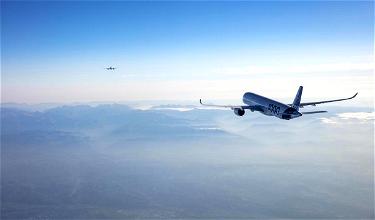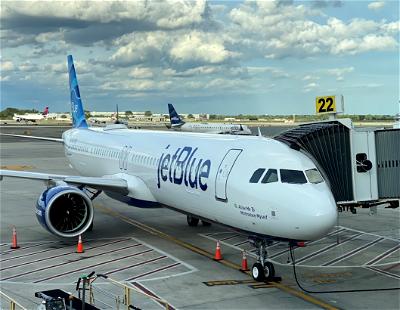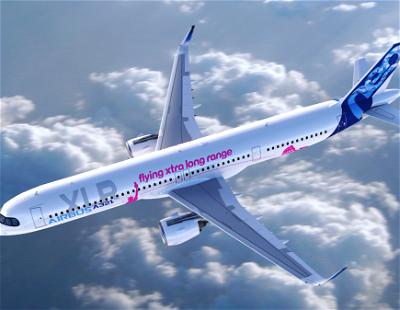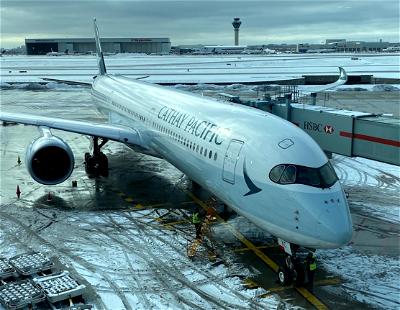Airbus has demonstrated how flying across the Atlantic in formation can save a good amount of fuel, though I question how useful this will be in the real world…
In this post:
Airbus A350s cross the Atlantic in formation
The entire aviation industry is looking for ways to reduce its environmental impact, both because it’s the right thing to do, and because reducing fuel burn also saves money. Along those lines, Airbus performed a fascinating demonstration flight across the Atlantic yesterday.
Specifically, on Tuesday, November 9, 2021, two Airbus A350 test aircraft crossed the Atlantic in formation, flying from Toulouse, France, to Montreal, Canada. Over the course of the flight, the two aircraft saved over six tons of CO2 emissions, which is the equivalent of over 5% fuel savings for this flight. That’s right, fuel burn was reduced by over 5% by flying in formation.
How is that possible? Well, Airbus has developed flight control systems that position the “follower” aircraft in the wake updraft of the “leader” aircraft, allowing the aircraft in the back to reduce engine thrust, and thereby reduce fuel consumption. It’s the same concept as how large migrating birds fly together in a distinct V-shaped formation.
The next step is to get support for this concept from authorities, so that this new operational concept can be certified, and enable airlines to reduce fuel burn.
Here’s how Sabine Klauke, Airbus’ Chief Technical Officer, described this flight:
“This demonstration flight is a concrete example of our commitment to making our decarbonisation roadmap a reality. It also speaks to how collaboration across the industry will be key to making this happen. We have received a strong level of support for this project from our airline and air traffic partners, plus regulators. The opportunity to get this deployed for passenger aircraft around the middle of this decade is very promising. Imagine the potential if fello’fly was deployed across the industry!”
This is awesome, but is it practical?
First and foremost, this is a ridiculously cool concept. Reducing fuel burn by over 5% is significant, and I’m sure that this could all be done in a safe manner with the right technology being used.
My bigger concern with this becoming a reality is the logistics:
- Presumably this only works if the same type of aircraft are crossing the ocean, since different planes have different cruising speeds, and presumably having similar systems would also help
- Is the concept here that this would apply for planes traveling between the same origin and destination at the same time, or rather that planes could be flying to totally different destinations, but just cross the main portion of the Atlantic around the same time?
- Unless the two airplanes belong to the same airline, how would the cost savings be split, given that one plane is essentially saving the other plane fuel?
- Airlines aren’t allowed to coordinate schedules without anti-trust immunity, so logistically how would this be coordinated? Would this be a case where air traffic controllers see if there are two planes close enough to one another for this to make sense, or to what extent would it be planned in advance?
Bottom line
Airbus performed an awesome demonstrator flight with two A350s. The planes crossed the Atlantic, with one aircraft being in the other aircraft’s wake, and this led to considerable fuel savings. It’s the same concept as birds flying in formation, as this allowed the plane in the rear to reduce its thrust, thanks to the wake updraft.
This is a great concept, though I’m skeptical of the real world uses here, based on the logistics involved.
What do you make of this Airbus formation flying concept, and do you think we could ever see this implemented on a widespread basis?





Ben, I really appreciate how much you know and share about things just beyond aviation.
Das ist toller Erfolg für Airbus.!****! .
In der Tat!
Woruldn't the follower aircraft air intake system be bringing in compromised air for its passengers to breathe??
Good initiative! This might lead to "plane trains" or "Air Trains". ;) So cool!
All the negativity in the comments here is so sad - how dare Airbus try to achieve something new! Are you questioning my God-given right to pollute the planet as much as I like? The comments to this thread are basically why I completely avoid watching TV or reading the newspaper every time I’m in the US…
This isn't an airport. You don't have to announce your departure.
The air ingested by the follower will have fumes from the lead aircraft's engines. Health and comfort issue?
The big question is the separation! How far apart were they, is this practical in the real day to day world?
If this is safe and valid they could use this in major corridors (need not be going to the same destination) and eventually all airlines would benefit, it does not mean they have to calculate who gets a portion of the savings.
It’s a start and we should welcome anything which allows air travel to prosper, thanks to more sustainable techniques.
Coordinated flights would create more airport crowding and thus longer security lines .
Ed, you're not looking at the big picture.
It's when the aircrafts enter the traffic lanes. So it doesn't really matter if it tookoff from LHR CDG or TLS. As long as Shanwick times their entry correctly, which can be done with our current systems already.
These "traffic lanes" are well established over the north Atlantic which means getting planes to follow each other for long distances is not a problem. See Wikipedia: https://en.wikipedia.org/wiki/North_Atlantic_Tracks.
All these carbon reducing measures over the years, and we're still told it's a crisis and we are in peril. At what point do people start to question this? If it was working, shouldn't we see some results?
So you are suggesting nothing works and we should keep polluting this planet?
Or you are suggesting climate problem is a hoax and we can still pollute this planet?
Maybe results can't be seen in your lifetime, but that doesn't mean there wouldn't be results.
Dose Fox News ever give you a solution?
Maybe that's why Al Gore was never President. But still works for the get a Noble quick scheme little...
So you are suggesting nothing works and we should keep polluting this planet?
Or you are suggesting climate problem is a hoax and we can still pollute this planet?
Maybe results can't be seen in your lifetime, but that doesn't mean there wouldn't be results.
Dose Fox News ever give you a solution?
Maybe that's why Al Gore was never President. But still works for the get a Noble quick scheme little Greta ('s parents) it trying to pull off.
By the way, what happen to the big hole in the ozone?
Al gore was never president because he didn't carry his own state. Also his "investments" in clean energy made him a very rich man
If I recall, Trump failed to carry his own state in both elections.
How questioning the military, the biggest polluter on the planet? That would be goal worth pursuing.
They could have asked BA1 and VS3 to do it.
And probably due to "software issues" and not "design issues" Boeing airplane cannot follow another plane.
Being in the wake updraft of the “leader” aircraft, would the "follower" aircraft undergo additional turbulence?
Yeah my mind went right to turbulence. Would the "follower" have a lot of it, and would the lead aircraft disrupt any naturally occurring turbulent air? Not that any of this matters because there's no way this happens for commercial flights, but still interesting.
Good question. The following aircraft should not experience any additional turbulence (theoretically) as long as the two aircraft maintain a precise speed and distance. Basically, the following aircraft will experience a continuous upward draft allowing it to reduce its air speed, yet maintaining the same amount of lift. Note that the travel duration may be slightly longer in doing this.
Airspeed is unchanged. The aircraft in the upwash doesn't have to produce as much lift, so it can lower it's angle of attack, creating less drag. This lessened drag allows the aircraft in trail to fly the same speed as the airplane in front at a lower power setting.
Wow
But sadly they wasted more fuel than they saved by having to circle in air to wait to get into formation, then circle on arrival to wait in line to land, as well as deviating from their optimal individual routes. Higher overall fuel burn, longer flight durations, and extra safety concerns. Is this progress? This is an idea that is going nowhere.
Yes, I'm sure no one ever thought about calculating those factors. You are truly a deep thinker.
So adaptive cruise control for airplanes. If another similar plane is ahead then queue up behind it. Makes sense.
I could see major corridor’s implementing this ! I think even with different aircraft there would be savings perhaps not as big but still… obviously safety is the biggest concern here and presumably a global alliance for all using these corridors will need to be established so facilitate the savings equally
does this "demonstration" not seem like a waste of fuel to attempt to prove something that is completely impractical? Unless these were delivery flights, they wasted fuel (and added CO2 to the atmosphere) basically for nothing. Kudos Airbus...
It's probably flight control and other pre-delivery tests for newly built aircraft. Probably similar to military flyovers at sporting events where it may seem wasteful, but those pilots and aircraft need to get the flight hours in any way to attain/maintain certification so might as well do something useful with it.